Tidy Toys
5 (Ingenius!) Rules For Organizing Play Spaces
The holidays are over and, if you have kids, you probably have lots of new toys lying around the house. Messes can be stressful, so before you lose your marbles (see what I did there?) be proactive about plaything placement. Evelyn Cucchiara, owner of The Toy Tamer in Madison, is here to help. I spoke to Evelyn, who’s knowledgeable, inventive and eager to corral the clutter of toys gone wild.

Cucchiara puts toys in their place.
It’s not just about organization, she says. It’s about mindset. With a degree in art therapy, Cucchiara has experience with the thought processes and behavior of kids and their parents. “Most of the time it’s the adults who have most of the trouble and can’t set anything up. Kids usually love having order and structure in their lives,” she says. As a former daycare provider, she has practical experience in messes. “I didn’t want to spend the end of every day putting toys away.”
For overworked parents who might feel the same way, Cucchiara says she can not only get play spaces organized; she can make sure the kids keep them organized. Have a look at Cucchiara’s tips before you step on even one more LEGO®.
1. Make It Fun and Easy
Cucchiara recommends labeling shelves and containers with pictures and written words. “When you have labels on the shelf where the toy belongs, it becomes a giant matching game. When the kids see a picture of their actual Barbies™, that’s immediate gratification. That’s the whole basis of toy taming. It’s removing obstacles. It’s easier for people of all ages to do it than not do it.”
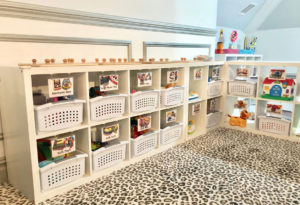
Magic markers: labeled shelves make it easy to see what goes where.
2. Select Storage Systems Wisely
Success depends upon choosing the right storage options. Cucchiara says that, while parents have good intentions, they can often go astray. “Most of the time the mom has put the toys in clear bins which she’s stacked nicely, so the child can never get to the toys again.”
Though bins and baskets are useful, says Cucchiara, “the most important thing is that they should be only half the size of the cubby they’re going into. You need to see what’s going in there. You need room for a label with a picture of the toy. If the bin takes up the whole cubby space, then it’s a three-step process to put a toy away.” Faced with the option of taking a bin out, putting a toy in and then putting the bin back, “the mom or the child sticks it somewhere else; but if the bin is only half the size, you walk by throw a toy in and you’re done.”
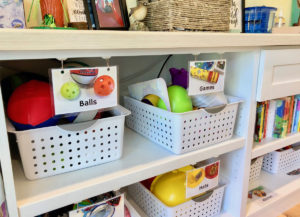
In this case, half measures work best.
Cucchiara also encourages the use of storage systems that “blend in with the rest of the house; that don’t scream ‘playroom.’” So many pieces designed for toys have a limited lifespan, with primary colors, etc. Using more generic or adult storage systems allows you to “have perfectly good storage once the kids are done with the toys.”
3. Be specific
Each toy should be stored according to what suits its size and shape. Cucchiara gave us options for a few types of popular toys.
Board games: “They now make most board games in square boxes so they’re easier to store.
- In a cubby, stack them only three or four high, and you won’t have an avalanche.
- In a closet with big shelves, stack them like books, with shelf dividers.
- If you have a lot of games, take the boards out of the boxes, store the game pieces in plastic, locking, re-closable bags. All the game boards get stored in one place and all the bags get labeled with the game’s name and then stored all in one bin.”
This next one’s my favorite!
- “Another cool way to store the games is to frame the game board, and then put the pieces in a ziplock and hang them on the back. This turns it into wall art!”
Shopkins™, Hot Wheels® cars, etc.: Cucchiara reworks shoe racks to hold smaller toys like these. You can see what you have without dumping out a bin.
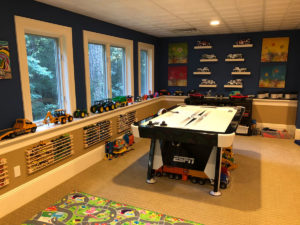
Tiny toys get out from underfoot on a repurposed shoe rack.
Lightsabers, Nerf Guns, etc.: “They’re big; they’ve all got unusual shapes. The best bet is a tall trashcan without a lid. Attach it to the wall so it won’t fall over.”
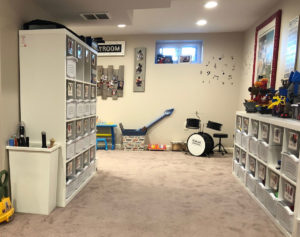
Stored in an upright position, Lightsabers are ready to grab at a moment’s notice should Darth Vader show up.
This “a place for every kind of toy and every toy in its place” strategy has other advantages as well. “If the room’s organized and you have an entire cubby of Peppa Pig™ and your child wants another Peppa Pig, you can ask, ‘Where would you put it? There’s no room in the Peppa Pig bin.’ It’s not mom being the bad guy.”
4. Put kids in control (a little)
Cucchiara has developed a system to signal that it’s time to put away toys. “Use a little concierge bell and say ‘let’s see how quickly we can match the toys to the pictures.’” After a few practice runs, it’s time for the kids to take over. “Two days later you let the child ring the bell. A few days after that, you just leave the bell where they can see it.”
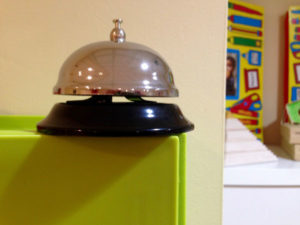
A bit Pavlovian, perhaps, but it puts the kids in charge of cleanup.
The beauty of the system is “the grownup never has to do it again. It promotes executive functioning skills and puts children in charge. They take pride in having a clean playroom. Take your average 5-year-old girl. All she wants to do is run the world and all her parents want her not to do is run the world. Everything from food to bedtime is dictated to her. She’s trying to run her own life.” This bell system gives her a bit of agency.
5. And understand the kids’ concerns
Another consideration when storing toys is the makeup of the family. How many kids live (and play) in this house? How old are they? How do they play? With LEGOs, for example, Cucchiara says, “you’re either the type of child who builds something and then takes it apart or the type who wants to keep the finished product.” Cucchiara makes sure to include high shelving for those kids who like to keep their new creations. “The shelves need to be high enough that the older child can reach them, but the younger child cannot. It’s reassuring to older children to know that projects are safe while they’re in school.”
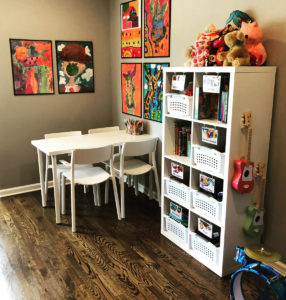
Keep older kids’ prized possessions out of reach of little siblings.
With these tips and a little bit of time, effort and kids’ cooperation, it’s possible to get—and maintain—an organized playroom. “I’ve never seen a playroom that we’ve done that became a mess again.” That’s music to a harried parent’s ears.
